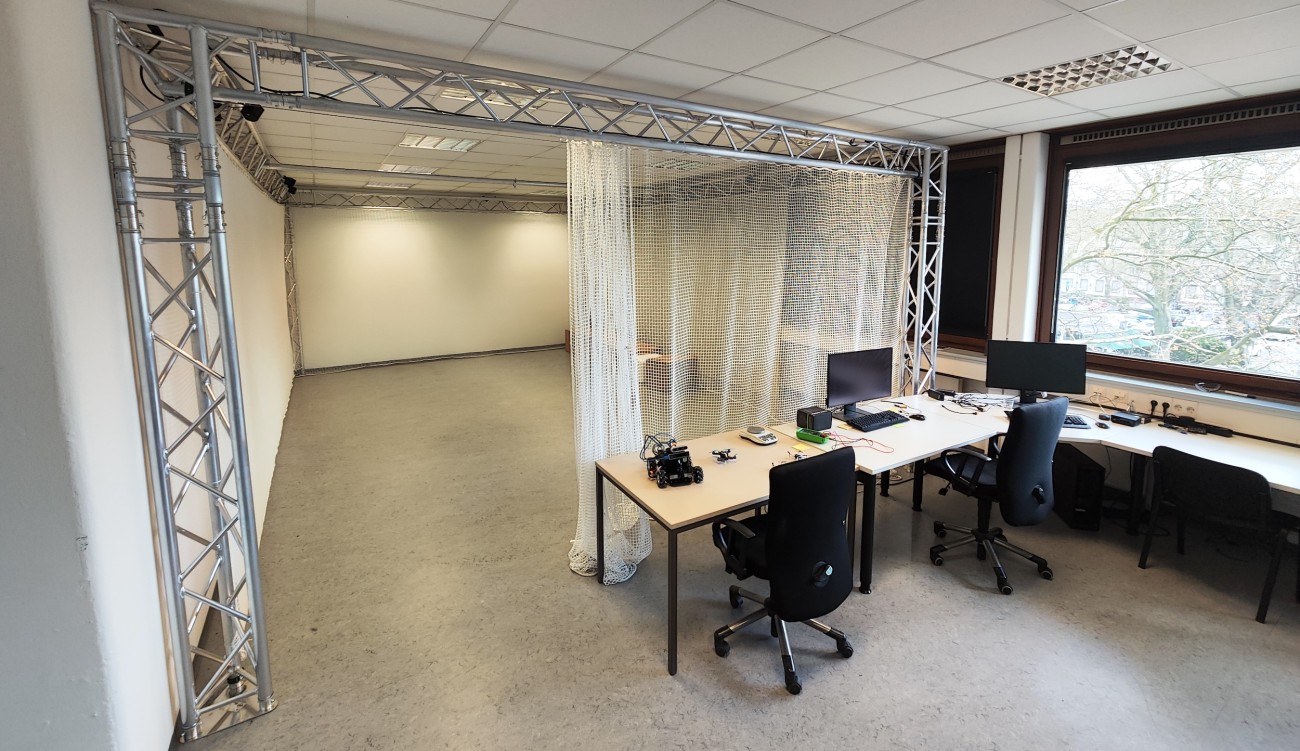Current Research in DroneLab
Autonomous UAV System for Surface Inspection
Surface inspection is a critical process in the automotive and vehicle leasing industries, traditionally performed by human inspectors or stationary scanning systems. Manual inspection is time-consuming and prone to human error, while stationary systems are often inflexible and expensive. This project showcases an autonomous UAV-based solution designed to address these limitations. Developed in-house, the UAV system leverages a state-of-the-art attention-based object detection model to accurately identify vehicles. Using stereo camera depth data, the UAV can autonomously navigate around a vehicle—regardless of its shape or size—and perform a full 360° surface inspection. The system offers a cost-effective, scalable, and highly adaptable alternative to conventional methods. It can be easily extended to inspect other types of vehicles, such as buses and trains, making it a versatile tool for modern automated inspection workflows.


Autonomous Inspection of Smoke Detectors using UAVs
Regular and thorough inspection of smoke and heat detectors is critical for ensuring their functionality in emergency situations. This task becomes particularly challenging in environments with high ceilings—such as industrial facilities, exhibition halls, and airports—where access is limited. This project presents a UAV prototype designed for autonomous, collision-free navigation in unknown and confined indoor spaces. The system explores its environment using an online backtracking spiral algorithm and employs a transformer-based real-time object detection model to identify smoke detectors mounted on the ceiling. Once positioned directly beneath a detector, the drone autonomously triggers a smoke spray to test the device, all while maintaining stable flight. The developed approach is adaptable and can be applied to a range of similar inspection tasks with minimal additional effort. This opens up promising opportunities for the broader use of autonomous UAVs across various industries.


Quadrotor-Based System for Aerial Physical Interaction
The advancement of unmanned aerial vehicles (UAVs) has led to a growing interest in aerial physical interaction, such as aerial grasping and pushing. However, achieving precise interaction remains challenging due to the floating-base nature of UAVs. Many existing multi-rotor aerial platforms address this challenge by incorporating tilted propeller orientations or additional actuators to manipulate the motor axes. However, these solutions often increase system complexity and payload. This project presents an aerial system composed of two identical standard quadrotors with non-planar rigid connections to achieve aerial manipulation tasks, such as pushing without changing orientation. The system provides an additional degree of freedom without requiring external actuators, allowing it to function directly as an end-effector. This minimizes mechanical complexity while maintaining adaptability for further modifications and reconfigurations.


Scalable Task-Driven Robotic Swarm Control via Collision Avoidance and Learning Mean-Field Control
In recent years, reinforcement learning and its multi-agent analogue have achieved great success in solving various complex control problems. However, multi-agent reinforcement learning remains challenging both in its theoretical analysis and empirical design of algorithms, especially for large swarms of embodied robotic agents where a definitive toolchain remains part of active research. We use emerging state-of-theart mean-field control techniques in order to convert many agent swarm control into more classical single-agent control of distributions. We combine collision avoidance and learning of mean-field control into a unified framework for tractably designing intelligent robotic swarm behavior. Overall, we propose a framework for the design of swarm behavior that is both mathematically well-founded and practically useful, enabling the solution of otherwise intractable swarm problems.


Nearest-Neighbor-based Collision Avoidance for Quadrotors via Reinforcement Learning
Collision avoidance algorithms are of central importance to many drone applications. In particular, decentralized approaches are key to enabling robust drone swarm systems when centralized communication becomes computationally prohibitive. In this work, we take biological inspiration from flocks of starlings (Sturnus vulgaris) and apply it to end-to-end learned decentralized collision avoidance. Specifically, we propose a scalable observation model based on a biomimetic nearest-neighbor information constraint, which enables fast learning and effective collision avoidance behavior. Using a general reinforcement learning framework, we develop an end-to-end learning-based method that integrates collision avoidance with arbitrary tasks such as package collection and formation change. To demonstrate the generality of the approach, we validate it using motion models of moderate complexity that incorporate momentum, while still allowing direct transfer to real-world quadrotors.








